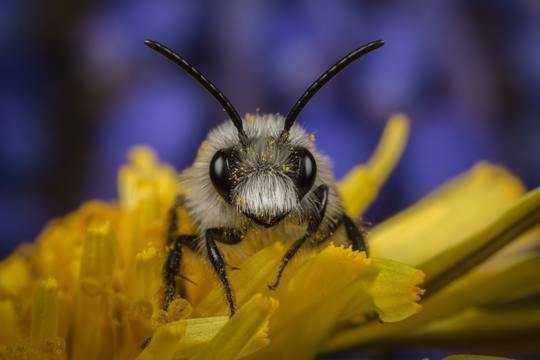 An ashy mining bee (Andrena cineraria) – one of the species believed to be on the increase. Ed Phillips/Shutterstock
An ashy mining bee (Andrena cineraria) – one of the species believed to be on the increase. Ed Phillips/Shutterstock
Many species of flower-visiting insect are in trouble in Britain, according to a new report from the Centre for Ecology and Hydrology (CEH) near Oxford, which drew on almost 750,000 observations of insects between 1980 and 2013. The study used population records of 353 wild bee and hoverfly species over large areas of Great Britain to show that one third of these pollinating species declined in range during this time.
Most of these losses were in species that were already relatively rare. Some big losers were the red-shanked carder bee, the smooth-gastered furrow bee and the large shaggy bee, all of which had vanished from around half of their previous locations in 1980.
However, the same report also found that other species of bee and hoverfly, about 10% of the total, actually increased. Some of these, like the ashy mining bee and the lobe-spurred furrow bee, are pollinators of field crops like oilseed rape. These two species increased their ranges five-fold during the same period, suggesting that crop-specialist species are thriving at the expense of most others.
The other winners were actually invaders. The ivy bee – most often seen on the plant of the same name – only colonised mainland Britain in 2001 and the range over which it can be found has been expanding by 16% every year since. Despite what may appear to be a mixed bag, the overall diversity of British pollinator species has fallen steadily since 1980.
Why do we need insects?
The new study underlines the already alarming downward trend in insect numbers seen in several other studies conducted in the UK, Germany and Central America. In February 2019, a report claimed that current rates of decline might lead to “the extinction of 40% of the world’s insect species over the next few decades”. This almost apocalyptic claim was rapidly taken up by the world’s press and attracted much attention. Even if that story was exaggerated, it is pretty clear that something is wrong in the state of nature.
Massive losses of insects are so serious because insects are essential components in almost every ecosystem. It’s their job to eat plants which convert the energy of sunlight into biomass – the foundation of most terrestrial food webs. In turn, these herbivorous insects are eaten by carnivorous insects, which are themselves eventually eaten by larger insect-eating animals. If insects are in trouble, then so is everything else in that ecosystem as serious losses in insect biodiversity threaten all kinds of wildlife.
Wild bee and hoverfly species are globally important in fertilising flowering plants by transferring pollen between them, causing them to set seed. Without them, seed production in many wild flowers is reduced and plant populations decline. With fewer flowers to visit and less nectar and pollen to gather, pollinator numbers decline even further in a vicious cycle.
It’s not only wild plants that are affected, but also agricultural crops. Strawberries, apples and oilseed rape are just three of many crops that benefit from pollination by bees and other insects. Production of seeds for planting is also dependent on insects. Without “ecological services” like insect pollination, some of these crops could no longer be grown. The annual value of insect pollinators for the UK alone has been estimated at £603m). Globally, pollination adds USD$153 billion to the economy each year.
Why have some species increased?
The new report notes that among those pollinating insects whose ranges have expanded, species associated with field crops are well represented. This could be because measures have been taken to encourage them such as planting wildflowers, which provide pollen when crops are not in flower. Alternatively, it may simply be that some species are more tolerant of the progressive intensification of farming practices than others.
Superficially, the increases in crop pollinators seem encouraging, but it may not be good news. Loss of pollinator diversity decreases crops yields, and this may be more important than insect numbers. Decreased pollinator diversity may leave insect populations more vulnerable to viral diseases that spread readily among social insects. Such viruses interact with widely-used pesticides and are known to adversely affect both honey bees and bumblebees.
Broadly speaking, biodiversity losses in farmland habitats are likely due to increases in the efficiency of farming. Farmers seek to grow the greatest crop yields on the area of land that’s available to them. This ensures that agriculture captures more and more of the sun’s energy, converting it into human food.
As farming efficiency increases, less space and fewer resources are left for anything other than human food crops. The recent study shows that a few crop-specialist pollinators have increased while the majority have not, which shows that fewer plants and animals are thriving in ecosystems which are increasingly dominated by agriculture. There’s a trade-off between wild nature and farming efficiency and it seems that we have to decide how much wild nature we want.![]()
About The Author
Stuart Reynolds, Emeritus Professor of Biology, University of Bath
This article is republished from The Conversation under a Creative Commons license. Read the original article.
Related Books
at InnerSelf Market and Amazon


























